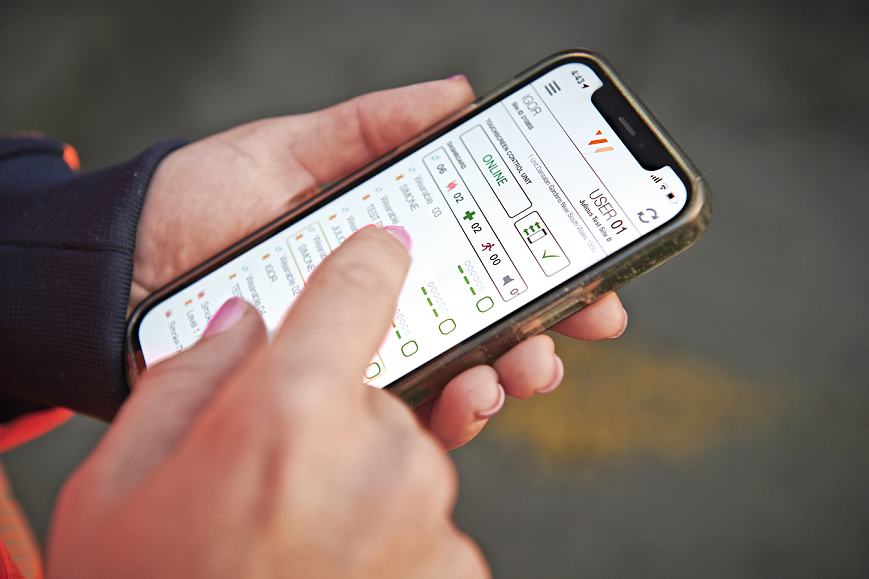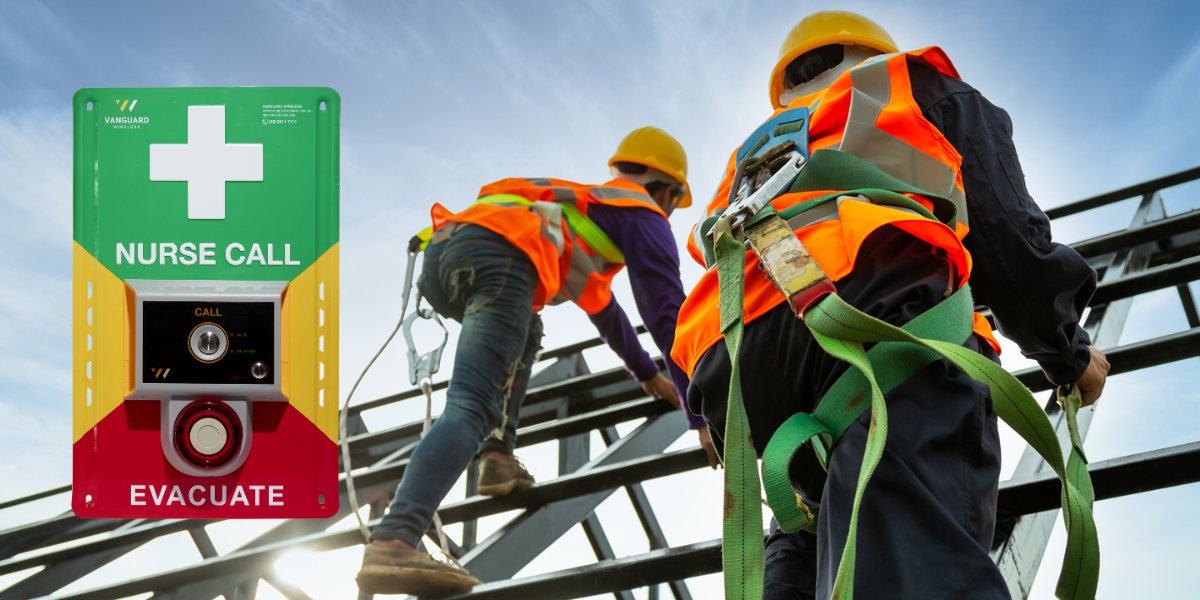Working from heights is an essential part of many jobs and projects, but it also comes with inherent risks. Falls from heights can result in severe injuries or even fatalities if proper safety precautions are not taken. To ensure a safe working environment when working at heights, it's crucial to follow a set of guidelines and practices such as regular workforce training, adherence to guidelines, using harnesses, and setting ladders and scaffolding up properly.
It's also critical to have an effective nurse call and evacuation system in place so if there is an accident, workers can quickly notify emergency response personnel, who can coordinate first aid and - if necessary - a site evacuation or lockdown.
Four Types Of Fall Hazards
There are typically four main types of fall hazards that you need to be aware of, particularly if you're working on a construction site.
Elevated Work Surfaces
Elevated work surfaces include anything above ground level such as ladders, scaffolding, or elevated platforms. Businesses must ensure that these surfaces have proper guardrails or handrails in place so workers do not slip or trip while working on them. Additionally, make sure that workers are wearing the necessary personal protective equipment (PPE) when working on elevated work surfaces such as hard hats and steel-toed boots.
Unprotected Edges
Unprotected edges refer to any edge of a surface that could lead to a fall if someone were to slip or trip over it without warning. For example, an open stairwell without guardrails is considered an unprotected edge hazard because someone could easily fall down it without any protection from falling further than intended. It’s important for employers to ensure that all unprotected edges have some kind of guardrail or handrail installed so accidents can be prevented from occurring.
Floor Openings
Floor openings refer to any type of gap in the flooring that could lead someone into a hazardous situation if they were to trip or slip over it without warning. These openings can be caused by faulty design or old materials which can make them hard to spot sometimes. To prevent accidents from occurring due to floor openings, employers should inspect their sites regularly and repair any gaps found immediately before someone suffers an injury.
Unstable Surfaces
Unstable surfaces refer to any type of surface that could lead someone into a hazardous situation if they were not aware of its instability beforehand. This includes wet floors, uneven terrain, slippery surfaces (such as fresh paint), etc., which all pose potential threats if not properly secured before allowing workers onto them for their job duties.
Preventative Measures
Using Harnesses
If you're working on the roof of a building - no matter how high - or somewhere there's a high risk of falling from, you need to use a harness. Depending on its design, a harness may be used to arrest a fall, prevent a fall from occurring, support the worker's position, or enable work in a suspended position by rope access. They distribute the force of a fall across the body, reducing the risk of injury.
- Make sure the harness fits snugly, is in good condition, and complies with relevant safety standards. Inspect it regularly for signs of wear and tear.
- Properly put on the harness: Follow the manufacturer's instructions for wearing the harness correctly. Ensure all buckles and straps are securely fastened.
- Connect to anchor points: Always connect your harness to a secure anchor point with a lanyard or lifeline. The anchor point should be strong enough to support your weight.
- Avoid hanging in suspension: If you fall, avoid hanging in suspension for an extended period, as it can lead to suspension trauma. This can be prevented by training and using fall arrest systems properly.
Proper Ladder Setup
Ladders are common tools for working at heights, but they can be hazardous if not used correctly. Also consider using a ladder in conjunction with a harness (see above) for added protection.
- Choose the right ladder: Ensure that the ladder you select is the appropriate height for the job and in good condition. Inspect it for any defects before use.
- Place on a stable surface: Set the ladder on a level, non-slip surface. Use ladder levelers or anti-slip mats if necessary.
- Angle matters: The angle of the ladder should be approximately 75 degrees from the ground. Follow the ladder manufacturer's recommendations for the specific type of ladder you're using.
- Three-point contact: Always maintain three points of contact with the ladder while climbing – two feet and one hand or two hands and one foot.
- No overreaching: Avoid overreaching while on the ladder. It's better to climb down and reposition the ladder than to risk losing your balance.
Working with a Spotter/s
Solo workers often face a greater risk of injury as they aren't supported by a team that can improve their safety and reduce their exposure to risk. It's always recommended that if you're working at heights, you ask at least one coworker to act as a spotter, which can significantly enhance safety. Spotters can provide assistance, guidance, and an extra set of eyes to identify potential hazards. They can also rectify issues or call for help if you need medical assistance.
- Communication is key: Establish clear communication with your spotter before starting the task. Agree on hand signals or verbal commands to communicate effectively.
- Regular check-ins: Periodically check in with your spotter to ensure they are aware of your position and any changes in the work environment.
- Stay focused: Trust your spotter and stay focused on the task. Avoid distractions and heed their warnings or instructions promptly.
Despite all safety precautions, accidents can still happen. It's vital to have a method for calling for help in case of an emergency. This includes using nurse call and evacuation triggers (which alert emergency response personnel to the incident), evacuation sirens, smartphone apps, SMS notifications, and two-way radio integrations. Workers can trigger an alert using a Vanguard Wireless system as follows:
- Using a worker wearable, nurse call trigger, evacuation trigger, or smartphone app, the worker presses the Call or Evacuate button to create an alert.
- Nominated personnel receive the alert via their smartphone. The alert can also trigger connected sirens to sound in a full or partial site evacuation.
- Emergency response personnel coordinate first aid or workforce movement in conjunction with the workplace emergency plan.
Training
Regular training should be delivered to workers on the location of emergency equipment and PPE (and how to use it), evacuation procedures, and medical emergency procedures. If the site is evolving rapidly - for example on a construction site - it's also important that workers understand where high risk areas exist, including fall hazards.
It can also be useful to hold first-aid and rescue training. Equipping yourself and your team with basic first-aid and rescue training - to provide immediate assistance until professional help arrives - can make a massive difference in the outcomes of a worker in medical distress.
Lastly you should run through your emergency plan to ensure it's up to date with key contacts, muster points, and communication KPIs.
Equipment Maintenance
Important equipment like first-aid kits and AEDs (Automated External Defibrillators) should be checked and maintained at least quarterly. AED pads and epi pens have expiry dates.
Battery powered evacuation triggers and nurse call triggers should be checked regularly to ensure they're receiving power. All systems should be tested to ensure they operate as intended. PPE should be checked, as should harnesses and other fall protection gear such as helmets.
By following these guidelines and prioritizing safety, you can reduce the risks associated with working at heights and ensure a secure working environment for yourself and your team. Always prioritize safety above all else when working at heights.


